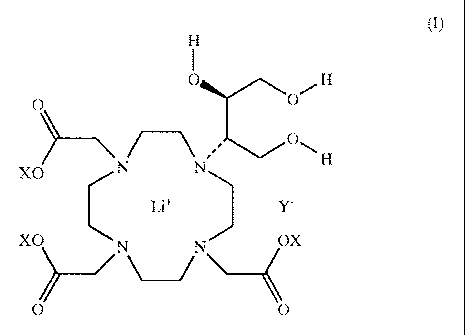Une partie des informations de ce site Web a été fournie par des sources externes. Le gouvernement du Canada n'assume aucune responsabilité concernant la précision, l'actualité ou la fiabilité des informations fournies par les sources externes. Les utilisateurs qui désirent employer cette information devraient consulter directement la source des informations. Le contenu fourni par les sources externes n'est pas assujetti aux exigences sur les langues officielles, la protection des renseignements personnels et l'accessibilité.
L'apparition de différences dans le texte et l'image des Revendications et de l'Abrégé dépend du moment auquel le document est publié. Les textes des Revendications et de l'Abrégé sont affichés :
| (12) Brevet: | (11) CA 2431976 |
|---|---|
| (54) Titre français: | COMPLEXES DE LITHIUM DU N-(1-HYDROXYMETHYL-2,3-DIHYDROXYPROPYL)-1,4,7-TRISCARBOXYMETHYL-1,4,7,10-TETRAAZACYCLODODECANE, LEUR FABRICATION ET LEUR UTILISATION |
| (54) Titre anglais: | LITHIUM COMPLEXES OF N-(1-HYDROXYMETHYL-2,3-DIHYDROXYPROPYL)-1,4,7-TRISCARBOXYMETHYL-1,4,7,10-TETRAAZACYCLODODECANE, THEIR PRODUCTION AND USE |
| Statut: | Durée expirée - au-delà du délai suivant l'octroi |
| (51) Classification internationale des brevets (CIB): |
|
|---|---|
| (72) Inventeurs : |
|
| (73) Titulaires : |
|
| (71) Demandeurs : |
|
| (74) Agent: | MARKS & CLERK |
| (74) Co-agent: | |
| (45) Délivré: | 2010-04-13 |
| (86) Date de dépôt PCT: | 2001-12-05 |
| (87) Mise à la disponibilité du public: | 2002-06-20 |
| Requête d'examen: | 2006-11-09 |
| Licence disponible: | S.O. |
| Cédé au domaine public: | S.O. |
| (25) Langue des documents déposés: | Anglais |
| Traité de coopération en matière de brevets (PCT): | Oui |
|---|---|
| (86) Numéro de la demande PCT: | PCT/EP2001/014283 |
| (87) Numéro de publication internationale PCT: | EP2001014283 |
| (85) Entrée nationale: | 2003-06-16 |
| (30) Données de priorité de la demande: | ||||||
|---|---|---|---|---|---|---|
|
L'invention concerne des complexes de lithium du N-(1-hydroxyméthyl-2,3-dihydroxypropyl)-1,4,7-triscarboxyméthyl-1,4,7,10 tétraazacyclododécane, leur fabrication ainsi que l'obtention du complexe de gadolinium, exempt de sels, du N-(1-hydroxyméthyl-2,3-dihydroxypropyl)-1,4,7-triscarboxyméthyl-1,4,7,10 tétraazacyclododécane à partir de ceux-ci, sans recourir à l'utilisation d'échangeurs d'ions.
The invention relates to crystalline lithium complexes of
N-(1-hydroxymethyl-2,3-dihydroxypropyl)-1,4,7-triscarboxymethyl-
1,4,7,10 tetraazacyclododecane, their production and the recovery
of the salt-free gadolinium complex of N-(1-hydroxymethyl-2,3-
dihydroxypropyl)-1,4,7-triscarboxymethyl-1,4,7,10
tetraazacyclododecane from the latter without the use of ion
exchangers.
Note : Les revendications sont présentées dans la langue officielle dans laquelle elles ont été soumises.
Note : Les descriptions sont présentées dans la langue officielle dans laquelle elles ont été soumises.

2024-08-01 : Dans le cadre de la transition vers les Brevets de nouvelle génération (BNG), la base de données sur les brevets canadiens (BDBC) contient désormais un Historique d'événement plus détaillé, qui reproduit le Journal des événements de notre nouvelle solution interne.
Veuillez noter que les événements débutant par « Inactive : » se réfèrent à des événements qui ne sont plus utilisés dans notre nouvelle solution interne.
Pour une meilleure compréhension de l'état de la demande ou brevet qui figure sur cette page, la rubrique Mise en garde , et les descriptions de Brevet , Historique d'événement , Taxes périodiques et Historique des paiements devraient être consultées.
| Description | Date |
|---|---|
| Inactive : Périmé (brevet - nouvelle loi) | 2021-12-06 |
| Représentant commun nommé | 2019-10-30 |
| Représentant commun nommé | 2019-10-30 |
| Lettre envoyée | 2013-07-24 |
| Accordé par délivrance | 2010-04-13 |
| Inactive : Page couverture publiée | 2010-04-12 |
| Lettre envoyée | 2010-02-08 |
| Inactive : Transfert individuel | 2010-01-22 |
| Préoctroi | 2010-01-22 |
| Inactive : Taxe finale reçue | 2010-01-22 |
| Un avis d'acceptation est envoyé | 2009-11-30 |
| Inactive : Lettre officielle | 2009-11-30 |
| Lettre envoyée | 2009-11-30 |
| Un avis d'acceptation est envoyé | 2009-11-30 |
| Inactive : Approuvée aux fins d'acceptation (AFA) | 2009-11-25 |
| Modification reçue - modification volontaire | 2009-06-30 |
| Inactive : Dem. de l'examinateur par.30(2) Règles | 2008-12-30 |
| Lettre envoyée | 2006-11-29 |
| Exigences pour une requête d'examen - jugée conforme | 2006-11-09 |
| Requête d'examen reçue | 2006-11-09 |
| Toutes les exigences pour l'examen - jugée conforme | 2006-11-09 |
| Modification reçue - modification volontaire | 2006-11-09 |
| Lettre envoyée | 2004-02-26 |
| Inactive : Transfert individuel | 2004-01-27 |
| Inactive : IPRP reçu | 2003-10-07 |
| Inactive : Lettre de courtoisie - Preuve | 2003-08-12 |
| Inactive : Page couverture publiée | 2003-08-11 |
| Inactive : Notice - Entrée phase nat. - Pas de RE | 2003-08-06 |
| Demande reçue - PCT | 2003-07-17 |
| Exigences pour l'entrée dans la phase nationale - jugée conforme | 2003-06-16 |
| Demande publiée (accessible au public) | 2002-06-20 |
Il n'y a pas d'historique d'abandonnement
Le dernier paiement a été reçu le 2009-11-23
Avis : Si le paiement en totalité n'a pas été reçu au plus tard à la date indiquée, une taxe supplémentaire peut être imposée, soit une des taxes suivantes :
Les taxes sur les brevets sont ajustées au 1er janvier de chaque année. Les montants ci-dessus sont les montants actuels s'ils sont reçus au plus tard le 31 décembre de l'année en cours.
Veuillez vous référer à la page web des
taxes sur les brevets
de l'OPIC pour voir tous les montants actuels des taxes.
Les titulaires actuels et antérieures au dossier sont affichés en ordre alphabétique.
| Titulaires actuels au dossier |
|---|
| BAYER INTELLECTUAL PROPERTY GMBH |
| Titulaires antérieures au dossier |
|---|
| HOLGER HOFFMANN |
| JOHANNES PLATZEK |
| ORLIN PETROV |
| PETER BLASZKIEWICZ |